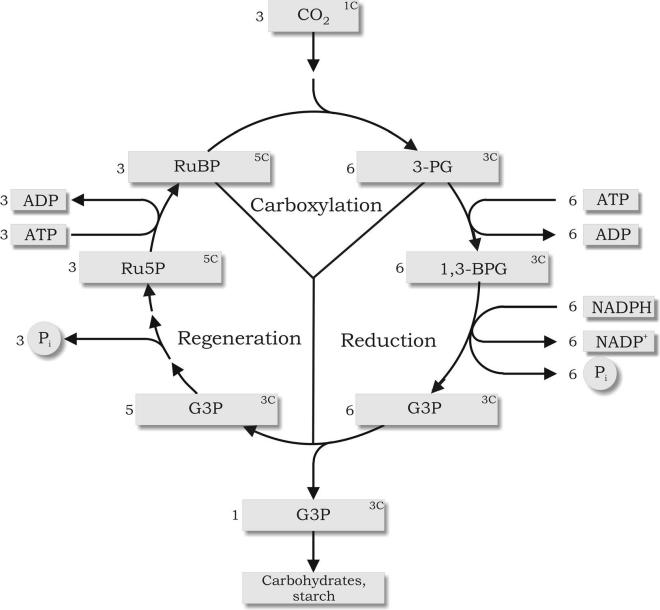Calvin Benson Bassham Cycle
- Carboxylation: fixation of CO2 into a stable organic intermediate
- Reduction: reduction of this intermediate to the level of carbohydrate
- Regeneration: regeneration of the CO2 accepto
Carboxylation involves the addition of one molecule of CO2 to a 5-carbon “acceptor” molecule, ribulose biphosphate (RuBP). This reaction is catalyzed by the enzyme RuBisCO. Plants invest a huge amount of their available nitrogen into making this one protein. As a result, RuBisCO is the most abundant protein in the biosphere. The resulting 6-carbon product splits into two identical 3-carbon products. These products are 3-phosphoglycerate, or simply 3-PG. At this point in the cycle, CO2 has been “fixed” into an organic product but no energy has been added to the molecule.
The second step in the Calvin cycle is the reduction of 3-PG to the level of carbohydrate. This reaction occurs in two steps: (1) phosphorylation of 3-PG by ATP to form a 1,3-biphosphoglycerate (1,3-BPG) and (2) reduction of 1,3-BPG by NADPH to form glyceraldehyde-3-phosphate (G3P), a simple 3-carbon carbohydrate, and its isomers collectively called triose phosphates. This reaction requires both ATP and NADPH, the high energy chemical intermediates formed in the light reactions.
The NADP+ and ADP formed in this process return to the thylakoids to regenerate NADPH and ATP in the light reactions.
Regeneration
The final stage in the Calvin cycle is the regeneration of the CO2 acceptor RuBP. This involves a series of reactions that convert triose phosphate first to the 5-carbon intermediate Ru5P (ribulose 5- phosphate), then phosphorylate Ru5P to regenerate RuBP (ribulose-bisphosphate). This final step requires ATP formed in the light reactions.
The triose phosphate formed in the Calvin cycle can remain in the chloroplast where it is converted to starch. This is why chloroplasts form starch grains. Alternatively, triose phosphate can be exported from the chloroplast where it is converted to carbohydrates in the cytoplasm. Both reactions involve the release of phosphate. In the case of carbohydrates, the phosphate must be returned to the chloroplast to support continued photophosphorylation (ATP formation).
The net energy balance of six rounds of the Calvin cycle to produce one mole of hexose is thus:
6CO2 + 18ATP + 12NADPH + 12H2O → C6H12O6 + 18ADP
+ 18Pi + 12NADP+ + 6H+(3:4)





